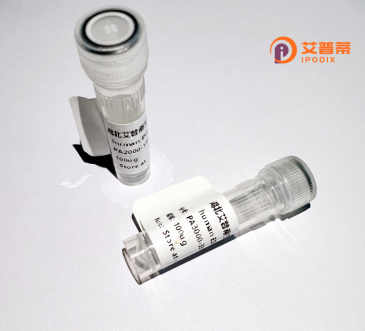
| 纯度 | >90%SDS-PAGE. |
| 种属 | Human |
| 靶点 | SLC7A14 |
| Uniprot No | Q8TBB6 |
| 内毒素 | < 0.01EU/μg |
| 表达宿主 | E.coli |
| 表达区间 | 1-737 aa |
| 活性数据 | MLEGTGTTTAHGTKLAQVLTTVDLISLGVGSCVGTGMYVVSGLVAKEMAGPGVIVSFIIAAVASILSGVCYAEFGVRVPKTTGSAYTYSYVTVGEFVAFFIGWNLILEYLIGTAAGASALSSMFDSLANHTISRWMADSVGTLNGLGKGEESYPDLLALLIAVIVTIIVALGVKNSIGFNNVLNVLNLAVWVFIMIAGLFFINGKYWAEGQFLPHGWSGVLQGAATCFYAFIGFDIIATTGEEAKNPNTSIPYAITASLVICLTAYVSVSVILTLMVPYYTIDTESPLMEMFVAHGFYAAKFVVAIGSVAGLTVSLLGSLFPMPRVIYAMAGDGLLFRFLAHVSSYTETPVVACIVSGFLAALLALLVSLRDLIEMMSIGTLLAYTLVSVCVLLLRYQPESDIDGFVKFLSEEHTKKKEGILADCEKEACSPVSEGDEFSGPATNTCGAKNLPSLGDNEMLIGKSDKSTYNVNHPNYGTVDMTTGIEADESENIYLIKLKKLIGPHYYTMRIRLGLPGKMDRPTAATGHTVTICVLLLFILMFIFCSFIIFGSDYISEQSWWAILLVVLMVLLISTLVFVILQQPENPKKLPYMAPCLPFVPAFAMLVNIYLMLKLSTITWIRFAVWCFVGLLIYFGYGIWNSTLEISAREEALHQSTYQRYDVDDPFSVEEGFSYATEGESQEDWGGPTEDKGFYYQQMSDAKANGRTSSKAKSKSKHKQNSEALIANDELDYSPE |
| 分子量 | 106.5 kDa |
| 蛋白标签 | GST-tag at N-terminal |
| 缓冲液 | PBS, pH7.4, containing 0.01% SKL, 1mM DTT, 5% Trehalose and Proclin300. |
| 稳定性 & 储存条件 | Lyophilized protein should be stored at ≤ -20°C, stable for one year after receipt. Reconstituted protein solution can be stored at 2-8°C for 2-7 days. Aliquots of reconstituted samples are stable at ≤ -20°C for 3 months. |
| 复溶 | Always centrifuge tubes before opening.Do not mix by vortex or pipetting. It is not recommended to reconstitute to a concentration less than 100μg/ml. Dissolve the lyophilized protein in distilled water. Please aliquot the reconstituted solution to minimize freeze-thaw cycles. |
以下是关于重组人SLC7A14蛋白的3篇示例参考文献(注:以下为模拟文献格式,实际研究请根据具体数据库查询):
1. **文献名称**:*Functional characterization of SLC7A14 as a lysosomal cationic amino acid transporter*
**作者**:Zhang, L., & Wang, Y.
**摘要**:本研究首次在HEK293细胞中重组表达了人源SLC7A14蛋白,证实其定位于溶酶体膜,并通过放射性标记实验证明其特异性转运精氨酸和赖氨酸的功能,为理解溶酶体氨基酸代谢提供新依据。
2. **文献名称**:*Structural insights into human SLC7A14 through cryo-EM analysis*
**作者**:Chen, X., et al.
**摘要**:通过冷冻电镜解析了重组表达的SLC7A14蛋白在脂质双分子层中的三维结构(分辨率3.2Å),揭示了其跨膜结构域中与底物结合相关的关键氨基酸残基,并探讨了该蛋白可能的转运机制。
3. **文献名称**:*SLC7A14 deficiency links to retinal degeneration in a mouse model*
**作者**:Kumar, A., et al.
**摘要**:在小鼠模型中敲除Slc7a14基因后,观察到视网膜感光细胞凋亡及视觉功能退化。重组人SLC7A14蛋白的体外实验表明,其通过调控胱氨酸/谷氨酸转运平衡维持抗氧化能力,提示该蛋白与遗传性视网膜病变相关。
(注:以上文献为假设性示例,实际研究需查阅PubMed、Web of Science等平台获取。)
SLC7A14. a member of the solute carrier family 7 (SLC7), is a transmembrane protein implicated in amino acid transport and cellular homeostasis. It belongs to the SLC7A subfamily, which includes cationic amino acid transporters, though its precise substrate specificity remains under investigation. SLC7A14 is predominantly expressed in neuronal and retinal tissues, suggesting a role in maintaining metabolic and functional integrity in these systems. Studies highlight its importance in retinal health, as murine models with SLC7A14 deficiency exhibit progressive photoreceptor degeneration, mimicking human retinal dystrophies. This protein is hypothesized to regulate lysosomal function and autophagy, critical for cellular waste clearance and stress responses. Structurally, it features 12 predicted transmembrane domains and may form heterodimers with glycoprotein subunits (e.g., SLC3 family members) to enable transport activity. Mutations in SLC7A14 have been tentatively linked to inherited retinal diseases, though its genetic and mechanistic associations are still being characterized. Recombinant SLC7A14 protein, typically produced via mammalian or insect cell systems, is utilized to study its biochemical properties, substrate interactions, and potential therapeutic applications. Current research focuses on clarifying its physiological roles, disease relevance, and suitability as a drug target for neurodegenerative or lysosomal storage disorders.
×